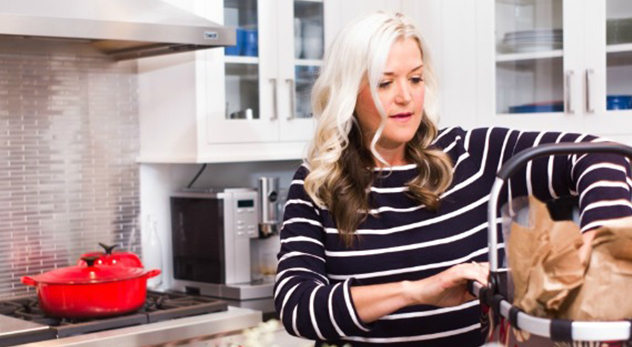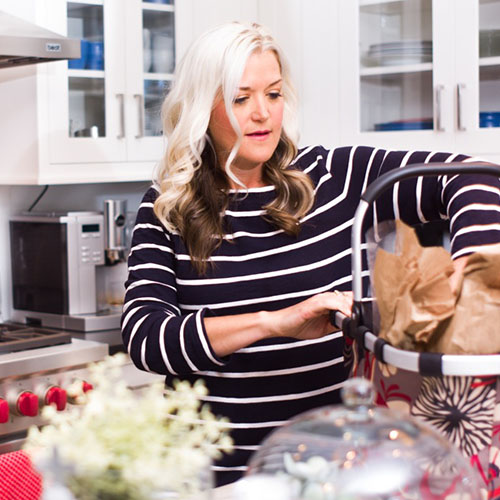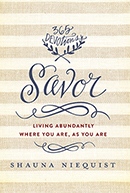
She’s gifted speaking on stage, but Shauna Niequist may be at her best when sitting at a table. – Image courtesy of Shauna Niequist
She’s gifted speaking on stage, but Shauna Niequist may be at her best when sitting at a table. The wildly popular speaker and blogger has written four books–three of which were named after food–and is on a mission to help Christians rediscover their tables as a sacred space. Her last book, Bread and Wine, paired spiritual insights with personal recipes. And her most recent book, Savor: Living Abundantly Where You Are, As You Are, takes readers on a 365-day journey to enjoy “work and play, coffee and kids, meals and prayers and the good stuff and the hard stuff.” Here we discuss why these concepts are so important to her, and even offers an never-before-shared recipe.
RNS: Life is busy for many people, but you’ve made it your mission to get people to slow down and “savor” their relationships with God and others. Why is this so important?
SN: Our culture values speed and efficiency, multi-tasking and hustling. When we sign on for those ways of living, we are indeed productive. We’re effective, we achieve. But those behaviors have a dark edge, too—if we’re not careful, they disconnect us from God, from ourselves, from those we love. They turn us more into machines than living, breathing humans. Over time, we lose our ability to see and think and feel on a deep level. I believe that’s a dangerous way to live.
In the last couple years I got closer to that edge than I ever want to again. In this season, I’m intentionally looking for ways to do less, to live more simply, to connect more deeply. It is making me less effective, certainly, in the conventional sense. I work less. I accomplish less. Things are messier around here. But the trade-off–for me and for the people I love–has been entirely worth it.
RNS: You point people to their kitchen tables and often integrate food is into your approach. What role does food play?
SN: The first is more obvious: [tweetable]Food is a way of loving people and connecting people.[/tweetable] While there are many great ways to connect—running together or quilting or cycling or whatever–I really believe that eating together, holding space for one another around the table, is a sacred and meaningful endeavor. The second is that food is a symbol for the whole material, tactile, messy, loud, smelly world God made. I love this world. I love the sounds and smells and textures, and they seem to me to be just as divine as the ideas and beliefs we hold about God. A lot of modern Christianity is about your head—right beliefs that don’t engage our senses or connect us to the world God made. Food gets us back to caring about material, tactile life, not just brains and ideas.
RNS: How can the table be a place where people can work through their disagreements?
SN: The table is where you log the time and earn the trust to disagree lovingly. You show up, week after week, spending hour upon hour. Over time, that builds a foundation upon which to have tremendously delicate and difficult conversations. Essentially, the table is the polar opposite of the Internet. The Internet is where we lob our opinions out, divorced from context and relationship. The table is where context and relationship form a protective cover around those deeply held feelings and opinions. The table is where you can look someone in the eye and say, “I love you, I see you, I know your story and how you came to believe what you believe. And I know you love me, you see me, and you know my story, too. And with great love, we disagree.”
RNS: How do you make time at the table? Is it freestyle scheduling or do you have a set time when you know you’re getting together with loved ones each week or month?
SN: Both. Most Wednesday evenings, my parents and brother stop over. It’s the loosest possible thing—I put out a bowl of Goldfish crackers and pretend it’s for the kids and then we all eat them. And then I pull out bits of whatever’s in the fridge—I fry up sausages and eggs or toss a salad while someone else opens the wine. We all standing around the kitchen island, catching up on our days with the kids running circles around us. Every Thursday, our small group of nine gather, most often at our house. I send around an email early in the week to see how many places to set at the table, and people take turns bringing dessert and drinks. These are not formal, fussy parties. They’re as close to family dinner as you can imagine—casual, connected, protected from the rush and hustle of the day, a safe place to land, to be seen and heard and known.
RNS: What do you say to the person who is overwhelmed by the thought of adding “table time” to their already busy life?
SN: Well, I know from experience that you can’t just add something to an already busy life without consequence, so the first thing I’d suggest is subtracting. [tweetable]Most of us could stand to work a little less.[/tweetable] Many of us are spending lots of time managing and organizing things we don’t need. Some of us have been drafted into volunteer roles that we resent, but we don’t have the courage to extricate ourselves.
I also find that the time I spend at the table is sort of a defense against all the to-dos and pressures. The table is the safe zone, where no one’s looking at their phones or trying to get anything done. It’s a bubble that we create, that we’re desperate for—we’re saying, for this hour, you don’t need to be anywhere but here. That’s a sacred and rare thing.
RNS: We all love exclusive. Give us a quick recipe that you’ve never shared before that we might use at our next table gathering.
SN: On Monday mornings, especially when the weekend’s been full, my favorite thing to do is putter in the kitchen and use up all the odds and ends in the refrigerator. Recently, I needed to find a use for four jalapeño peppers and decided to make salsa with them. The more traditional version would use mostly tomatoes, a little jalapeño, a touch of garlic, but I do about 40 percent tomatoes, 40 percent jalapeños, and 20 percent garlic. And then I eat it with a spoon. I love how roasting all three ingredients changes the flavor so much—it’s not harsh, like it would be raw. It’s mellower, richer—perfect on almost anything. So here you go:
ROASTED JALAPENO SALSA
Ingredients
4 jalapeños, halved, ribs and seeds removed
2 handfuls grape tomatoes, halved
10 cloves garlic, peeled
Olive oil
Salt
Preheat the oven to 425 degrees. Toss the jalapeños, tomatoes, and garlic with about a tablespoon of oil, then roast for 15 to 20 minutes, tossing once, or until jalapeños are soft but not charred. Let it cool, then blend in food processor with a little bit of salt, just until there are small chunks, not all the way to a paste. You can eat it on anything from chips to breakfast tacos to a rice bowl to a burger.








